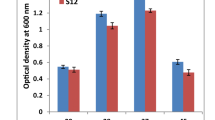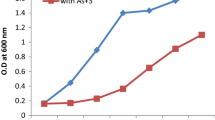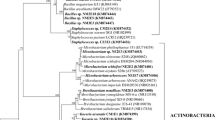Abstract
Arsenite oxidizing bacteria, isolated from industrial wastewater, showed high resistance against arsenite (40 mM) and other heavy metals (10 mM Pb; 8 mM Cd; 6 mM Cr; 10 mM Cu and 26.6 mM As5+). Bacterial isolates were characterized, on the basis of morphological, biochemical and 16S rRNA ribotyping, as Bacillus cereus (1.1S) and Acinetobacter junii (1.3S). The optimum temperature and pH for the growth of both strains were found to be 37 °C and 7. Both the strains showed maximum growth after 24 h of incubation. The predominant form of arsenite oxidase was extracellular in B. cereus while in A. junii both types of activities, intracellular and extracellular, were found. The extracellular aresenite oxidase activity was found to be 730 and 750 µM/m for B. cereus and A. junii, respectively. The arsenite oxidase from both bacterial strains showed maximum activity at 37 °C, pH 7 and enhanced in the presence of Zn2+. The presence of two protein bands with molecular weight of approximately 70 and 14 kDa in the presence of arsenic points out a possible role in arsenite oxidation. Arsenite oxidation potential of B. cereus and A. junii was determined up to 92 and 88 % in industrial wastewater after 6 days of incubation. The bacterial treated wastewater improved the growth of Vigna radiata as compared to the untreated wastewater. It indicates that these bacterial strains may find some potential applications in wastewater treatment systems to transform toxic arsenite into less toxic form, arsenate.







Similar content being viewed by others
References
Achour AR, Bauda P, Billard P (2007) Diversity of arsenite transporter genes from arsenic-resistant soil bacteria. Res Microbiol 158:128–137
Albarracin VH, Avila AL, Amoroso MJ, Abate CM (2008) Copper removal ability by Streptomyces strains with dissimilar growth patterns and endowed with cupric reductase activity. FEMS Microbiol Lett 288:141–148
Ali I, Hadi F, Bano A (2012) Microbial assisted phytoextraction of metals and growth of soybean (Glycine Max L. Merrill) on industrial waste water contaminated soil. Pak J Bot 44(5):1593–1599
Anderson CR, Cook GM (2004) Isolation and characterization of arsenate-reducing bacteria from arsenic contaminated sites in New Zealand. Curr Microbiol 48:341–347
Anderson GL, Williams J, Hille R (1992) The purification and characterization of arsenite oxidase from Alcaligenes faecalis, a molybdenum-containing hydroxylase. J Biol Chem 267:23674–23682
Bachate SP, Nandre VS, Ghatpande NS, Kodam KM (2013) Simultaneous reduction of Cr(VI) and oxidation of As(III) by Bacillus firmus TE7 isolated from tannery effluent. Chemosphere 90:2273–2278
Bahara MM, Megharaja M, Naidua R (2012) Kinetics of arsenite oxidation by Variovorax sp. MM-1 isolated from a soil and identification of arsenite oxidase gene. J Hazard Mater S0304-3894(12)01182-X
Brandstetter A, Lombi E, Wenzel WW, Adriano DC (2000) Arsenic-contaminated soils: I. Risk assessment. In: Wise DL, Trantolo DJ, Cichon EJ, Inyang HI, Stottmeister U (eds) Remediation engineering of contaminated soils. Dekker, New York, p 715
Butt AS, Rehman A (2011) Isolation of arsenite-oxidizing bacteria from industrial effluents and their potential use in wastewater treatment. World J Microbiol Biotechnol 27:2435–2441
Campos VL, Escalante G, Yañez J, Zaror CA, Mondaca MA (2009) Isolation of arsenite-oxidizing bacteria from a natural biofilm associated to volcanic rocks of Atacama Desert, Chile. J Basic Microbiol 49:S93–S97
Cappuccino JG, Sherman N (2001) Microbiology: a laboratory manual, 6th edn. Pearson Education, Benjamin Cummings, San Francisco
Cavalca L, Zanchi R, Corsini A, Colombo M, Romagnoli C, Canzi E, Andreoni V (2010) Arsenic-resistant bacteria associated with roots of the wild Cirsium arvense (L.) plant from an arsenic polluted soil, and screening of potential plant growth-promoting characteristics. Syst Appl Microbiol 33:154–164
Chang J-S, Yoon I-H, Kim K-W (2007) Isolation and ars detoxification of arsenite-oxidizing bacteria from abandoned arsenic-contaminated mines. J Microbiol Biotechnol 17:812–821
Conrads T, Hemann C, George GN, Pickering IJ, Prince RC, Hille R (2002) The active site of arsenite oxidase from Alcaligenes faecalis. J Am Chem Soc 124(38):11276–11277
Di Toppi LS, Gabbrielli R (1999) Response to cadmium in higher plants. Environ Exp Bot 41:105–130
Donahoe J, D’Imperio S, Jackson C, Inskeep W, McDermott T (2004) Arsenite-oxidizing Hydrogenobaculum strain isolated from an acid-sulfate-chloride geothermal spring in Yellowstone National Park. Appl Environ Microbiol 70:1865–1868
Duquesne K, Lieutaud A, Ratouchniak J, Muller D, Lett M-C, Bonnefoy V (2008) Arsenic oxidation by a chemoautotrophic moderately acidophilic Thiomonas sp.: from the strain isolation to the gene study. Environ Microbiol 10(1):228–237
Ellis PJ, Conrads R, Hille R, Kuhn P (2001) Crystal structure of the 100 kDa arsenite oxidase from Alcaligenes faecalis in two crystal forms at 1.64 Å and 2.03 Å. Structure 9:125–132
Fisher JC, Hollibaugh JT (2008) Selenate-dependent anaerobic arsenite oxidation by a bacterium from Mono Lake California. Appl Environ Microbiol 74:2588–2594
Garcia-Dominguez E, Mumford A, Rhine ED, Paschal A, Young LY (2009) Novel autotrophic arsenite-oxidizing bacteria isolated from soil and sediments. FEMS Microbiol Ecol 66:401–410
Ghafoor A, Rauf A, Arif M, Muzaffar W (1994) Chemical composition of effluents from different industries of the Faisalabad. Pak J Agric Sci 33:73–74
Heinrich-Salmeron A, Cordi A, Brochier-Armanet C, Halter D, Pagnout C, Abbaszadeh-fard E, Montaut D, Seby F, Bertin PN, Bauda P, Arsène-Ploetze F (2011) Unsuspected diversity of arsenite-oxidizing bacteria revealed by a widespread distribution of the aoxB gene in prokaryotes. Appl Environ Microbiol 77:4685–4692
Jackson CR, Harrison KG, Dugas SL (2005) Enumeration and characterization of culture able arsenate resistant bacteria in a large estuary. Syst Appl Microbiol 28(8):727–734
Jinbo X, Wenming W, Haoxin F, Gejiao W (2007) Arsenite-oxidizing Agrobacterium and arsenic resistant microorganisms of a Chinese coal mine ecosystem1. State Key Laboratory of Agricultural Microbiology, Huazhong Agricultural University, Wuhan, http://www.paper.edu.cn
Kashyap DR, Botero LM, Lehr C, Hassett DJ, McDermott TR (2006) A Na+:H+ antiporter and a molybdate transporter are essential for arsenite oxidation in Agrobacterium tumefaciens. J Bacteriol 188:1577–1584
Koechler S, Cleiss-Arnold J, Proux C, Sismeiro O, Dillies M-A, Goulhen-Chollet F, Hommais F, Lièvremont D, Arsène-Ploetze F, Coppée J-Y, Bertin PN (2010) Multiple controls affect arsenite oxidase gene expression in Herminii monasarsenicoxydans. BMC Microbiol 10:53
Krumova K, Nikolovska M, Groudeva V (2008) Isolation and identification of arsenic-transforming bacteria from arsenic contaminated sites in Bulgaria. Biotechnol Biotechnol Equip 22:721–728
Laemmli UK (1970) Cleavage of structural proteins during the assembly of the head of bacteriaphage T4. Nature 227:680–685
Leist M, Casey RJ, Caridi D (2000) The management of arsenic wastes: problems and prospects. J Hazard Mater 76:125–138
Lenoble V, Deluchat V, Serpaud B, Bollinger J-C (2003) Arsenite oxidation and arsenate determination by the molybdene blue method. Talanta 61:267–276
Liu SX, Athar M, Lippai I, Waldren C, Hei TK (2001) Induction of oxyradicals by arsenic: implication for mechanism of genotoxicity. Proc Natl Acad Sci USA 98:1643–1648
Mateos LM, Ordonez E, Letek M, Gil JA (2006) Corynebacterium glutamicumas a model bacterium for the bioremediation of arsenic. Int Microbiol Off J Span Soc Microbiol 9:207–215
Mokashi SA, Paknikar KM (2002) Arsenic (III) oxidizing Microbacterium lacticum and its use in the treatment of arsenic contaminated groundwater. Lett Appl Microbiol 34:258–262
Mukhopadhyay R, Rosen BP, Phung LT, Silver S (2002) Microbial arsenic: from geocycles to genes and enzymes. FEMS Microbiol Rev 26:311–325
Muller D, Lievremont D, Simeonova DD, Hubert JC, Lett MC (2003) Arsenite oxidase aox genes from a metal-resistant beta proteobacterium. J Bacteriol 185:135–141
Neff JM (1997) Ecotoxicology of arsenic in the marine environment. Environ Toxicol Chem 16:917–927
Newman DK, Ahmann D, Morel FM (1998) A brief review of microbial arsenate respiration. Geomicrobiology 15:255–268
Ordonez E, Letek M, Valbuena N, Gil JA, Mateos LM (2005) Analysis of genes involved in arsenic resistence in Corynobacterium glutamicumATCC1303. Appl Environ Microbiol 71:6206–6215
Oremland RS, Stolz JF (2005) Arsenic, microbes and contaminated aquifers. Trends Microbiol 13:45–49
Pasha C, Narayana B (2008) Determination of arsenic in environmental and biological samples using toluidine blue or safranine O by simple spectrophotometric method. Bull Environ Contam Toxicol 81:47–51
Pattanapipitpaisal P, Brown NL, Macaskie LE (2001) Chromate reduction and 16S rRNA identification of bacteria isolated from a Cr(VI)-contaminated site. Appl Microbiol Biotechnol 57:257–261
Prasad KS, Subramanian V, Paul J (2009) Purification and characterization of arsenite oxidase from Arthrobacter sp. Biometals 22:711–721
Quéméneur M, Heinrich-Salmeron A, Muller D, Lie`vremont D, Jauzein M, Bertin PN, Garrido F, Joulian C (2008) Diversity surveys and evolutionary relationships of aoxB genes in Aaerobic arsenite-oxidizing bacteria. Appl Environ Microbiol 74:4567–4573
Raja CE, Omine R (2012) Arsenic, boron and salt resistant Bacillus safensis MS11 isolated from Mongolia desert soil. Afri J Biotechnol 11(9):2267–2275
Rehman A, Ashraf S, Qazi JI, Shakoori AR (2005) Uptake of lead by a ciliate Stylonychia mytilus, isolated from industrial effluents: potential use in bioremediation of wastewater. Bull Environ Contam Toxicol 75:290–296
Rehman A, Ali A, Muneer B, Shakoori AR (2007) Resistance and biosorption of mercury by bacteria isolated from industrial effluents. Pak J Zool 39(3):137–146
Rehman A, Butt AS, Hasnain S (2010) Isolation and characterization of arsenite oxidizing Pseudomonas lubricansand its potential use in bioremediation of waste water. Afr J Biotechnol 9(10):1493–1498
Sambrook J, MacCallum P, Russell D (2001) Molecular cloning: a laboratory manual, 3rd edn. Cold Spring Harbor Laboratory Press, Cold Spring Harbor, New York
Santini JM, Hoven RNV (2004) Molybdenum-containing arsenite oxidase of the chemolithoautotrophic arsenite oxidizer NT-26. J Bacteriaology 186:1614–1619
Santini JM, Sly LI, Schnagl RD, Macy JM (2000) A new chemolithotrophic arsenite-oxidising bacterium isolated from a gold mine: phylogenetic, physiological, and preliminary biochemical studies. Appl Environ Microbiol 66:92–97
Silver S, Phung LT (2005) A bacterial view of the periodic table: genes and proteins for toxic inorganic ions. J Ind Microbiol Biotechnol 32:587–605
Simeonova D, Lievremont D, Lagarde F, Muller D, Groudeva V, Lett M-C (2004) Microplate screening assay for detection of arsenite oxidizing and arsenate-reducing bacteria. FEMS Microbiol Lett 237:249–253
Stolz JF, Basu P, Santini JM, Oremland RS (2006) Arsenic and selenium in microbial metabolism. Annu Rev Microbiol 60:107–130
Stools JF, Oremland RS (1999) Bacterial respiration of arsenic and selenium. FEMS Microbiol Rev 23(5):615–627
Wackett LP, Dodge AG, Ellis LBM (2004) Microbial genomics and then periodic table. Appl Environ Microbiol 70:647–655
Wang X, Rathinasabapathi B, de Oliveira L, Guilherme L, Ma L (2012) Bacteria-mediated arsenic oxidation and reduction in the growth media of arsenic hyperaccumulator Pteris vittata. Environ Sci Technol 46:11259–11266
Acknowledgments
This work was supported by the research Grant No. 20/1373/R&D/10 from Higher Education Commission (HEC), Islamabad Pakistan which is gratefully acknowledged.
Author information
Authors and Affiliations
Corresponding author
Ethics declarations
Conflict of interest
The authors have declared that no competing interests exist.
Electronic supplementary material
Below is the link to the electronic supplementary material.
Rights and permissions
About this article
Cite this article
Naureen, A., Rehman, A. Arsenite oxidizing multiple metal resistant bacteria isolated from industrial effluent: their potential use in wastewater treatment. World J Microbiol Biotechnol 32, 133 (2016). https://doi.org/10.1007/s11274-016-2079-3
Received:
Accepted:
Published:
DOI: https://doi.org/10.1007/s11274-016-2079-3




